 IST,
IST,
भारतीय गणतंत्रके सिक्के
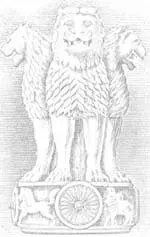
'भारत ने 15 अगस्त 1947 को स्वतंत्रता प्राप्त की। संक्रमण की अवधि के दौरान भारत ने पूर्ववर्ती समय की मुद्रा प्रणाली और मुद्रा एवं सिक्कों को जारी रखा। जहां पाकिस्तान ने सिक्कों की नई शृंखलाएं 1948 में और नोटों की शृंखालाएं 1949 में शुरू की वहीं भारत ने अपने विशेष सिक्के 15 अगस्त 1950 को जारी किए।
कालक्रमानुसार भारतीय गणतंत्र की सिक्का निर्माण नीति पर प्रभाव डालनेवाले मुख्य विचार निम्नानुसार हैं:
1. स्वतंत्रता के संदर्भ में संप्रभुता के प्रतीकों और देशी अवधारणाओं को शामिल करना;
2. मेट्रिक प्रणाली को लागू करते हुए सिक्का निर्माण में सुधार:
3. समय-समय पर यह आवश्यकता महसूस की गई कि सिक्कों की धातु का मूल्य उसके अंकित मूल्य से अधिक न बन पाए
4. मुद्रा नोटों को सिक्का रूप में जारी करने के लागत लाभ ।
स्वतंत्र भारत के निर्गमों को मोटे रूप से निम्नानुसार वर्गीकृत किया जा सकता है
यह भारतीय गणतंत्र की स्थापना होने तक के संक्रमणकाल के दौरान की मुद्रा व्यवस्थाओं का प्रतिनिधित्व करती है। 192 पाइ वाले एक रुपए की मुद्रा प्रणाली अपरिवर्तित रही।
1 रुपया = 16 आना
1 आना = 4 पैसा
1 पैसा = 3 पाइ
यह शृंखला 15 अगस्त 1950 को शुरू की गई और इसने भारतीय गणतंत्र के प्रथम सिक्का निर्माण का प्रतिनिधित्व किया। राजा के चित्र को हटाकर उसकी भगह शौर्य के प्रतीक अशोक स्तंभ के सिंह की आकृति उकेरी गई। एक रुपए के सिक्केपर बाघ की जगह मक्के की बालियों ने ले लीं। एक तरह से इसने प्रगति और उन्नति पर ध्यान केंद्रित करने के बदलाव का प्रतिनिधित्व किया। अन्य सिक्कों पर भारतीय अवधारणाओं को शामिल किया गया। मौद्रिक प्रणाली आम तौर पर अपरिवर्तित रही जिसमें 16 आने का एक रुपया होता था।
निकेल
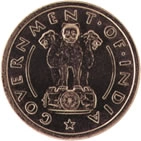
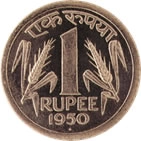
निकेल
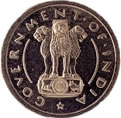
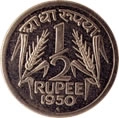
निकेल
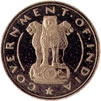
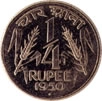
ताम्र- निकेल
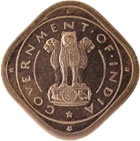
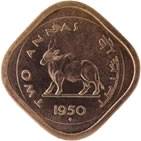
ताम्र- निकेल
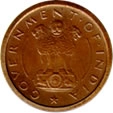
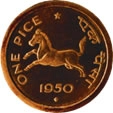
ताम्र- निकेल


कांस्य


एक शताब्दी तक दशमलवकरण अभियान जारी रहा। तथापि सितंबर 1955 में भारतीय सिक्का ढलाई अधिनियम में संशोधन किया गया, ताकि देश में सिक्का निर्माण के लिए मेट्रिक प्रणाली को स्वीकार किया था सके। यह अधिनियम 1 अप्रैल 1957 से लागू किया गया। रुपए के मूल्य और नाम में कोई परिर्वतन नहीं किया गया। तथापि, इसे 16 आना अथवा 64 पैसे के स्थान पर 100 पैसे में विभाजित किया गया। नया दशमलव पैसा सार्वजनिक स्वीकार्यता के लिए 1 जून 1964 तक नया पैसा' कहा जाता था परंतु इस तारीख के बाद 'नया' शब्द हटा दिया गया।
निकेल 10 ग्राम वृत्ताकार 28 मिमी.
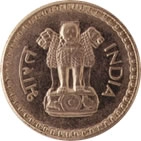
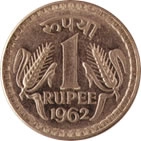
निकेल 5 ग्राम वृत्ताकार 24 मिमी.
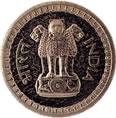
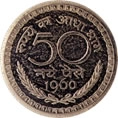
निकेल 2.5 ग्राम वृत्ताकार 19 मिमी.
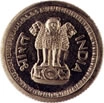
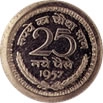
ताम्र-निकेल 5 ग्राम आठ मेहराबवाला 23 मिमी. (सभी मेहरबों को मिलाकर )
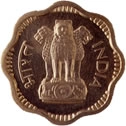
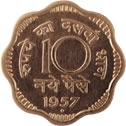
ताम्र-निकेल 4 ग्राम वर्गाकार 22 मिमी. (गारों कोनों को मिलाकर )
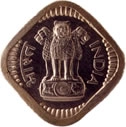
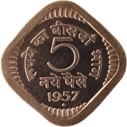
ताम्र-निकेल 3 ग्राम आठ मेहराबवाला 18 मिमी (सभी मेहरबों को मिलाकर )


कांस्य 1.5 ग्राम वृत्ताकार 16 मिमी.


साठ के दशक में वस्तुओं के मूल्य में वृद्धि के साथ छोटे मूल्यवर्ग के सिक्के भी कांस्य, निकेल पीतल, ताम्र-निकेल और एल्यूमिनियम कांस्य में ढाले जाते थे क्रमशः एल्यूमिनियम में ले जाने लगे। यह परिवर्तन 3 पैसे के नए षट्कोणीय सिक्कों को लागू करने के साथ शुरु हुआ। वर्ष 1968 में बीस पैसे का एक सिक्का जारी किया गया लेकिन इसे अधिक लोकप्रियता हासिल नहीं हुई।
निकेल 5 ग्राम वृत्ताकार 24 मिमी
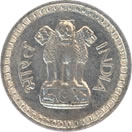
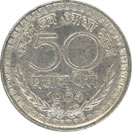
निकेल 2.5 ग्राम वृत्ताकार 19 मिमी.
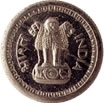
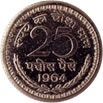
ताम्र-निकेल 5 ग्राम आठ मेहराबवाला 23 मिमी. (सभी मेहरबों को मिलाकर )
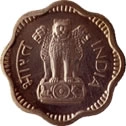
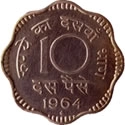
ताम्र-निकेल वर्गाकार 4 ग्राम 22 मिमी. (गारों कोनों को मिलाकर )
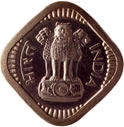
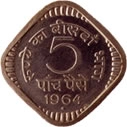
ताम्र-निकेल 3 ग्राम आठ मेहराबवाला 18 मिमी (सभी मेहरबों को मिलाकर )


कांस्य 1.5 ग्राम वृत्ताकार 16 मिमी.


In 1965, the elaborate descriptions were dropped and the word ‘paisa’/ ‘paise’ was used both in Hindi and English.
ताम्र- निकेल 8 ग्राम वृत्ताकार 28 मिमी
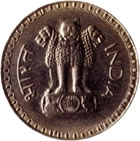
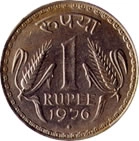
ताम्र- निकेल 5 ग्राम वृत्ताकार 24 मिमी
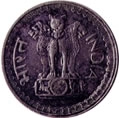
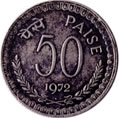
ताम्र- निकेल 2.5 ग्राम वृत्ताकार 19 मिमी
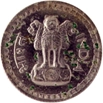
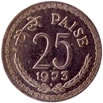
निकेल-पीतल 4.5 ग्राम वृत्ताकार 22 मिमी
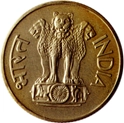
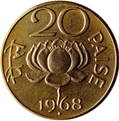
एल्यूमिनियम मैग्नेशियम 2.3 ग्राम मेहराबवाला 26 मिमी. (सभी मेहराबों को मिलाकर )
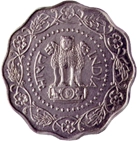
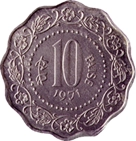
निकेल-पीतल 4.24 ग्राम आठ मेहराबवाला 23 मिमी
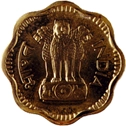
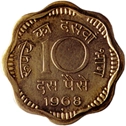
एल्यूमिनियम मैग्नेशियम 4 ग्राम वर्गाकार 22 मिमी.(कर्ण)
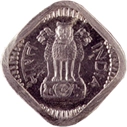
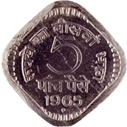
एल्यूमिनियम मैग्नेशियम 1.25 ग्राम षट्कोणीय 21 मिमी. (कर्ण)

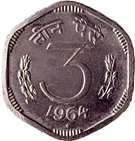
एल्यूमिनियम मैग्नेशियम 1 ग्राम मेहराबवाला 20 मिमी. (सभी मेहराबों को मिलाकर)


एल्यूमिनियम मैग्नेशियम 0.75 ग्राम वर्गाकार 17 मिमी. (कर्ण)
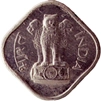
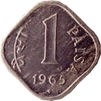
ताम्र- निकेल 6 ग्राम वृत्ताकार 26 मिमी
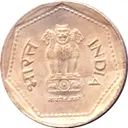
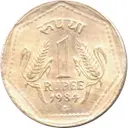
ताम्र- निकेल 5 ग्राम वृत्ताकार 24 मिमी
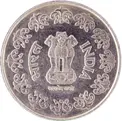
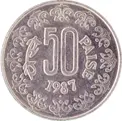
एल्यूमिनियम मैग्नेशियम 2.2 ग्राम षट्कोणीय 26 मिमी. (कर्ण) 24.5 मिमी (सभी फलकों को मिलाकर)
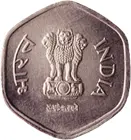
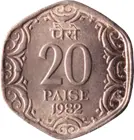
एल्यूमिनियम मैग्नेशियम 1.75 ग्राम मेहराबवाला 23 मिमी (सभी मेहराबों को मिलाकर )
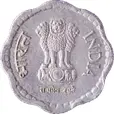
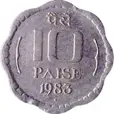
एल्यूमिनियम मैग्नेशियम 1.5 ग्राम वर्गाकार 22 मिमी. (कर्ण)
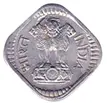
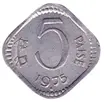
वर्षों बाद लागत लाभ को ध्यान में रखकर 1. 2 और 3 पैसे के सिक्कों को क्रमशः सत्तर के दशक में बंद कर दिया गया तथा 10, 25 और 50 पैसे के स्टेनलेस स्टील के सिक्केवर्ष 1988 में और एक रुपया के सिक्के वर्ष 1992 में जारी किए गए नोटों के निर्गम की लागत के कारण 1 रुपए, 2 रुपए और 5 रुपए के नोटों को 1990 के दशक के प्रारंभ से धीरे-धीरे इसी मूल्यवर्ग में सिक्कों के रूप में बदल दिया गया।
फेरेटिक स्टेनलेस स्टील 4.85 ग्राम वृत्ताकार 25 मिमी
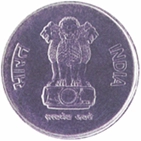
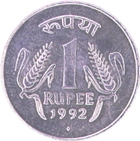
फेरेटिक स्टेनलेस स्टील 3.79 ग्राम वृत्ताकार 22 मिमी
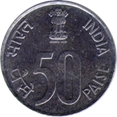
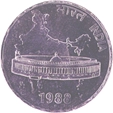
फेरेटिक स्टेनलेस स्टील 2.83 ग्राम वृत्ताकार 19 मिमी


फेरेटिक स्टेनलेस स्टील 2 ग्राम वृत्ताकार 16 मिमी


In 1982, the Rs. 2/- coin was introduced depicting the India map superimposed with the national flag explaining National integration. In 1992, the Rs. 5/- definitive coin in cupro-nickel was introduced to supplement the paper currency. Lotus buds and flower with stems and leaves became the main motif of this denomination. The lotus symbol was re-introduced on Rupee symbol series in 2011 for all denominations except Rs. 10/-.
ताम्र-निकेल 9 ग्राम वृत्ताकार 23 मिमी
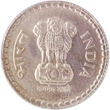
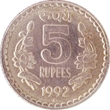
ताम्र-निकेल 8 ग्राम वृत्ताकार 28 मिमी
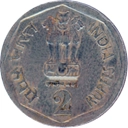
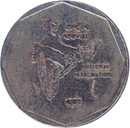
ताम्र-निकेल 6 ग्राम ग्यारह मेहराबवाला 26 मिमी
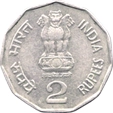
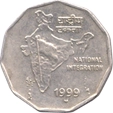
Coins of Republic of India since 2000
In 2003 the demand for coins, particularly of lower denominations, had declined considerably. There was a reverse flow of coins of 5 paise, 10 paise and 20 paise denominations. It was, therefore, decided to phase out from circulation all lower denomination coins such as 5 paise, 10 paise and 20 paise and cupro-nickel coins of 25 paise, 50 paise and one rupee.
In view of the reported melting of Rs.2 cupro-nickel coins due to rising metal prices, the Government of India in consultation with the Reserve Bank of India decided to mint all denomination coins in ferritic stainless steel (FSS) in 2006.
The first decade of the 21st century witnessed many new varieties of definitive coinage of the Indian Republic and put into circulation for general public. The increase in the demand of the metallic currency lead to the introduction of a few new series namely
1) Unity in Diversity
2) Nritya Mudra and
3) Connectivity and Information Technology.
They depicted the solidarity of the Indian public, rich cultural heritage, advancement in information technology and connectivity. For the first time, the concept of using bi-metal in manufacturing coins was introduced for Rs. 10/- to avoid counterfeiting.
The new coin series has been designed with tactile factor for visually challenged people with new graphic look. The Government of India, Ministry of Finance entrusted National Institute of Design (NID), Ahmedabad with the task of designing the new series.
In 2005, a series namely ‘Unity in Diversity’ was introduced in denominations of Re. 1/- followed by Rs. 2/- and Rs. 10/- in 2005. These issues, however, came into circulation in 2006. The Unity in Diversity has intersecting line/s with 4 dots.
2005-06 Unity in diversity Series
Bimetallic Cupro-Nickel in Center Aluminium Bronze in outer ring 7.71 gm Circular 27 mm
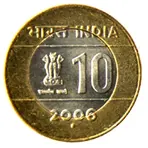
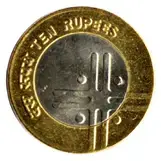
Ferritic Stainless Steel 5.62 gm Circular 27 mm
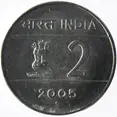
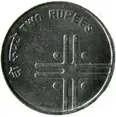
Ferritic Stainless Steel 4.85 gm Circular 25 mm
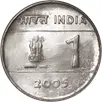
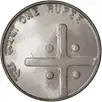
In 2007 a new series known as ‘Nritya Mudra’ was introduced in the denominations of 50 paise, Re. 1/- and Rs. 2/-. These coins were of ferritic stainless steel. The gestures used on the 50 paise was “Clenched Fist”, on Re. 1/- “Thumbs Up” and on Rs. 2/- was “Two Fingers”
2007 Nritya Mudra Series
Ferritic Stainless Steel 5.62 gm Circular 27 mm
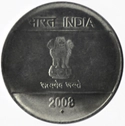
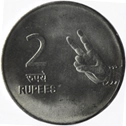
Ferritic Stainless Steel 4.85 gm Circular 25 mm
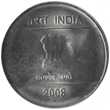
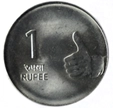
Ferritic Stainless Steel 3.79 gm Circular 19 mm


In 2007, Rs. 5/- ferritic stainless steel coin with waves in its design was issued. In 2008, a new Rs. 10/- coin with 15 rays connecting inner and outer rings/circles was issued. These are 2 distinct designs, one is radiating sun rays symbolising vertical flow and the other is water waves depicting the smooth fluid mass expanding horizontally representing the ceaseless flow of data/information in the atmosphere.
2007-09 Connectivity and Information Technology Series
Bimetallic Cupro-Nickel in Center Aluminium Bronze in outer ring 7.71 gm Circular 27 mm
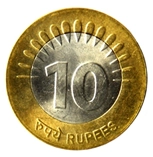
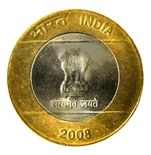
Ferritic Stainless Steel 6 gm Circular 23 mm
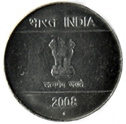
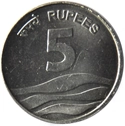
In 2009 Rs. 5/- coin design was again reverted to the previous lotus motif
Nickel Brass 6 gm Circular 23 mm
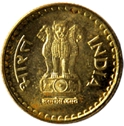
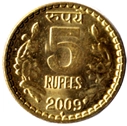
In 2011, the Rupee symbol (₹), the identity mark of Indian rupee was introduced in denominations of ₹1, 2 and 5 depicting lotus buds and flower with stems and leaves on either side of the denominational value. The ₹10 coin continued to be issued in bi-metal as previously with ‘₹’ above the numeric value with ten rays instead of fifteen. New 50 paise denomination also issued in the new series.
2011 Rupee Symbol Series
Bimetallic Cupro-Nickel in Center Aluminium Bronze in outer ring 7.71 gm Circular 27 mm
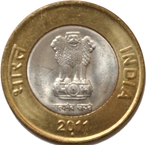
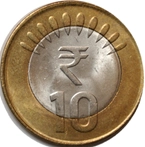
Nickel Brass 6 gm Circular 23 mm
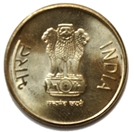
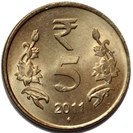
Ferritic Stainless Steel 4.85 gm Circular 25 mm
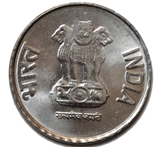
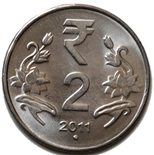
Ferritic Stainless Steel 3.79 gm Circular 22 mm
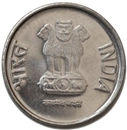
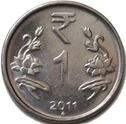
Ferritic Stainless Steel 2.83 gm Circular 19 mm
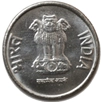
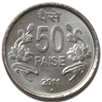
In the exercise of powers conferred by Section 15A of the Coinage Act, 1906 (3 of 1906), the Government of India decided to call in from circulation coins of denomination of 25 paise and below with effect from end-June 2011. Thereafter, these coins ceased to be legal tender for payment as well as on account.










